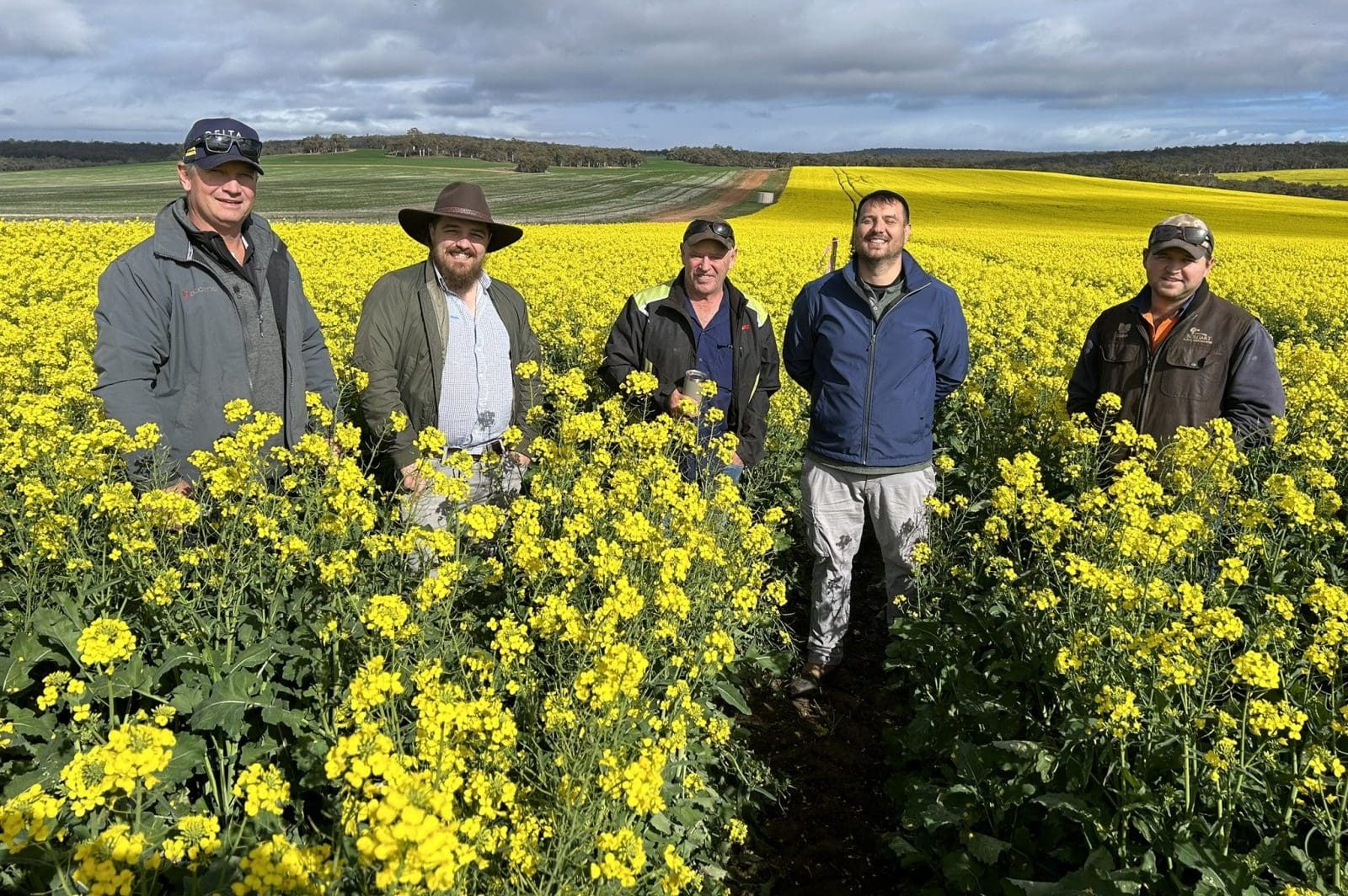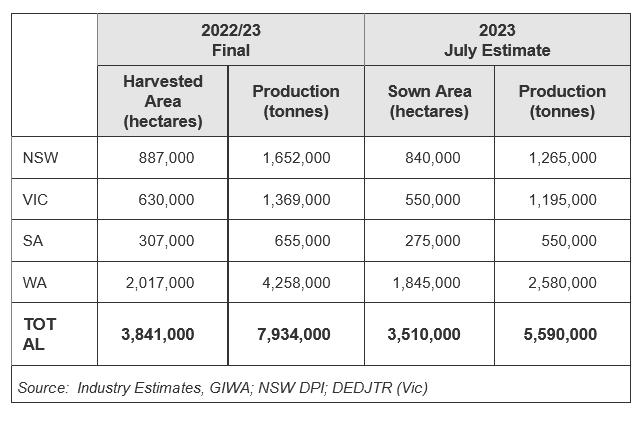
Lester Snooke, Willow Liddle, Barry Clarke, Vlad Pajic and Jarrod Clarke in the Clarke’s Hyola Regiment XC crop growing in Bolgart in the Kwinana South zone and expected to yield more than 3.5t/ha. Photo: Andrew Heinrich, Pacific Seeds WA canola specialist
THE Australian Oilseeds Federation has released its estimate gauged last month of mainland Australia’s new-crop canola, and pegged production at 5.59 million tonnes (Mt), down 30 percent from last year’s record of 7.93Mt.
This is 14pc above ABARES initial 2023-24 estimate of 4.9Mt, largely because of yield-boosting rain which fell in June after ABARES released its June Australian Crop Report.
In its commentary of figures released today to non-members, AOF said early season Bureau of Meteorology prospects for a drier season, combined with a softening in prices, have seen the national canola area drop 9pc from last year’s record.
Despite the drop in area, the current estimate for area sown is 20pc above the five-year and 35pc above the 10-year average, suggesting a greater adoption of canola into farming systems as well as tighter rotations.
The AOF forecast is based on known conditions at the time of writing, with only minimum yield impact from potentially drier and conditions applied in the light of the El Niño alert first issued by the BOM in early June.
“Crops in WA are more likely to have a yield impact from drier conditions.” AOF chief executive officer Nick Goddard said in the AOF’s latest crop report.
“Throughout most east-coast growing regions, sufficient sub-soil moisture in areas where crops are well established should mitigate against moisture stress, although warmer temperatures may impact flowering, pod and oil formation.”

Table 1: AOF estimates for Australia’s 2022-23 and 2023-24 canola. Source: State organisations
Following is a round-up of conditions by state:
New South Wales
Weed, disease and pest pressure are generally low throughout NSW, where the area sown to canola is only down marginally.
A lower-than-average yield estimate has been applied to the NSW crop, given the drier outlook for the remainder of the season.
Seasonal rain has been better than initial predictions for central and southern NSW, but northern NSW is divided by two extremes, roughly on the north-south axis of the Newell Highway.
In north-east NSW, many crops with split germinations have variable growth stages, with some just starting to flower.
Most crops have been fertilised for yield targets of 1.8-2.5 tonnes per hectare.
In north-west NSW, the lack of sufficient rainfall has restricted planting of most winter crops, including canola.
In central NSW, canola sown early to mid-April has begun flowering with excellent crop growth to date.
The good start to the season combined with good subsoil moisture has given growers confidence to apply plenty of nitrogen pre and early post sowing.
Later-sown crops planting up to mid-May are showing very slow growth rates, especially where nitrogen application was limited.
Many crops are still uneven after marginal sowing moisture and patchy small rainfall events, despite soil moisture profiles generally better than 50-60pc full.
Southern NSW is experiencing excellent conditions, as reflected in near-ideal plant growth to date.
Around 75pc of the crop was sown on time, with average to above-average temperatures experienced since sowing.
Warmer conditions have supported growth in aphid numbers which have acted as a virus vector resulting in loss of some crops in the Cowra and Canowindra districts.
In the west of the southern region, canola crops are reported to be in full bloom.
Victoria
Following a dry May, timely and rain in June was welcomed.
Victoria’s north-west and central north areas experienced Decile 10 rainfall, twice the norm for June, resulting in poor trafficability and waterlogging on heavier soil types.
Soil moisture in much of the west of the state, including the Mallee, was at Decile 10 during June, and this was accompanied by above-average or warmer temperatures.
Wet conditions have resulted in unprecedented slug pressure in some areas.
July rainfall fell back to drier than average, while above-average temperatures have not impacted crops.
The drier start to the season saw growers pull back on their canola area with AOF estimating a 13% reduction in area on prior year however this is up 20% on the five-year average as canola becomes firmly entrenched in the farming systems and rotations become tighter.
South Australia
Yield potential for SA is looking very good, with 70pc plus soil-moisture profiles in most districts as the crop comes into flowering.
Tight canola rotations combined with a cautious approach to the longer-term seasonal prospects has seen the area sown to canola in the state fall about 10pc from last year.
Most of the SA crop was sown early after timely Easter rainfall.
After a drier May, June rainfall was well above average which, together with above-average temperatures in June, produced rapid growth and set up good yield potential.
Follow-up rainfall in early July further increased confidence and bolstered good soil-moisture reserves.
Conditions have favoured an increase in the presence of slugs.
In the south-east, the area sown this year is reported to be up on last year but wet conditions and massive slug levels have reduced viable crop area.
Growers have had to apply up to four bait applications in some areas.
Area in the Murray-Mallee is up slightly from last year, with crops looking generally good, despite a week of frosts in late July, and some crops are at about 20pc flowering.
In the Mid North, crops are looking good, except for slug damage, and area is expected to be similar to last year.
On Yorke Peninsula, canola area is up on last year, although lentils remain the main break crop sown, and little slug pressure is evident.
On Eyre Peninsula, canola area is up on last year, particularly on the coastal edges, and crops are looking very good, despite below-average July rainfall
Western Australia
Drier conditions at sowing compounded by drier prospects for the season and very tight rotations have seen WA’s canola area drop by about 10pc off last year’s record planted area, but remain 20-30pc above the longer-term five and 10-year averages for the state.
WA crops have had a variable start, with widespread June rain lifting overall crop prospects.
A very cold June has slowed crop growth, particularly in southern regions.
The Geraldton zone is very dry and has had well below-average rainfall; early sown canola is patchy and struggling. Small
rain events have resulted in crops briefly recovering before moisture stress slowed growth again.
In the Kwinana and North Midlands districts, delayed sowing and drying soil has resulted in patchy canola crops, and these have responded to closer-to-average rainfall in June and patchy showers in early July.
Below-average temperatures have delayed flowering by roughly four weeks.
The Kwinana zone has had a very good start to the season.
Early sowing and rapid uniform crop emergence have given growers confidence to go strong with nitrogen and aim for above-average yield, and flowering commenced mid-July.
June rain completely changed the outlook for canola in the Albany zone, where areas with patchy canola responded quickly, and yield prospects have generally moved towards average.
Coastal areas are extremely wet.
In the Esperance zone, delayed crop growth is widespread, with very mixed crop status.
There are reports of waterlogged crops on the coast after 200mm or more of rain in June, and more in early July.
Source: AOF

HAVE YOUR SAY